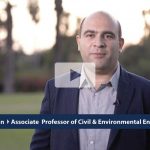You see, I’m an environmental engineer. And a lot of problems right now we are looking at – global warming and the current drought, climate change – these are the emerging issues, these are the pressing problems of the 20th century. And my field specifically addresses those problems – pollution in the atmosphere, hydrosphere, you know, little sphere. So soil pollution, groundwater, air – so these are the attributes I talk about. We are an integral part of society. For example, if you’re holding a glass of water, I can probably say that an environmental engineer has treated that water to the extent that it is beneficial to your health, it is protective of your health. We are not going to get diarrhea by drinking this water. So I take pride in the fact that we make these things possible, you know. Human endeavor is possible in every step of the way. What students can certainly expect from my class is a fun-filled class, an opportunity to learn something new, an opportunity to practice the hard, hands-on, participatory, intellectually exciting, they can sufficiently expect to have the rigor and substance. I decided to meet with my students and I’m passionate about teaching. I’m someone who can actually look forward to going to the class. That’s me.
Environmental Engineer Examining the Effects of Water and Soil Contaminants
Environmental engineers are integral to protecting people’s health – from the air they breathe to the water they drink. Sudarshan Kurwadkar, professor of civil and environmental engineering, encourages his students to take pride in the fact that their research makes human endeavors possible.







